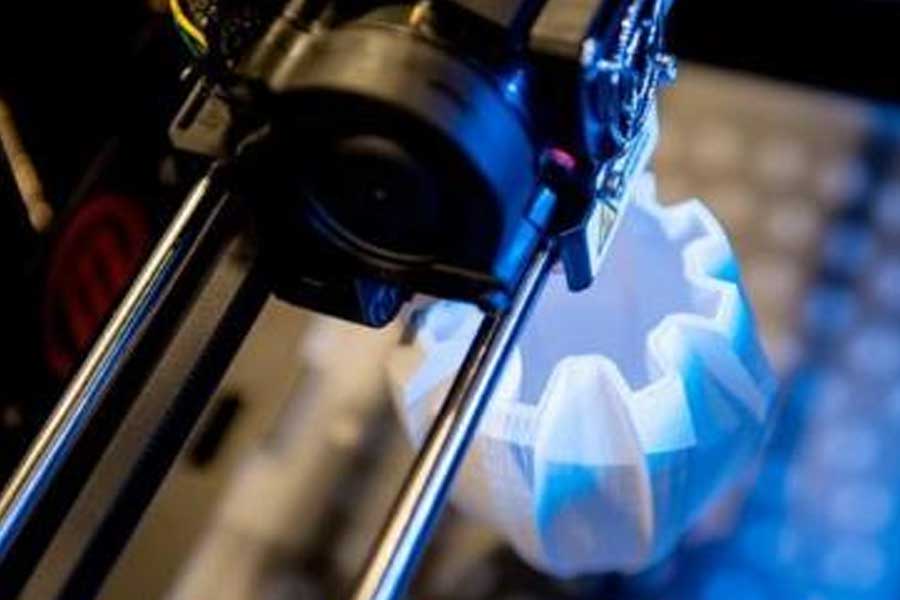Laser powder bed fusion is the dominant additive manufacturing technology and has not yet reached its potential. The problem facing the industry is that sometimes tiny bubbles or holes are formed during the printing process, and these holes form weak points in the final product.
In the 3D printing process of parts, when the low-speed high-power laser is melting the metal powder, a keyhole-shaped cavity is formed in the molten pool. The hole (ie, defect) is formed at the bottom of the keyhole. New research published in the journal Science reveals how holes are created and become defects that solidify in the metal.
Anthony D. Rowlett, professor of materials science and engineering in the School of Engineering at Carnegie Mellon University and the main co-author of “Science” said: “The real practical value of this research is that we can precisely control the machine to avoid this problem. .”
Based on previous studies that quantified the keyhole phenomenon, the research team used very bright high-energy X-ray imaging technology to observe the instability of the keyhole. The hole is formed during the fluctuation of the keyhole and changes its shape: the tip of the keyhole is deformed into a “J” shape and is clamped. This unstable behavior generates acoustic waves in the liquid metal, which forces the holes away from the keyhole, allowing them to survive long enough to be trapped in the solidified metal. The team is the first to focus on this behavior and determine what is happening.

“When you have a deep keyhole, the wall will vibrate strongly. Sometimes, the vibration at the bottom of the keyhole is strong enough that they will be clamped, leaving a large bubble behind. Sometimes, the bubble will never regenerate. Connect to the main keyhole. Sound waves will be generated. This will push the remaining pores away from the keyhole.” Rollett explained.
It is important to note that keyholes themselves are not a defect, for example, they can increase the efficiency of the laser. They noticed that researchers can use synchrotron radiation X-ray equipment, and they noticed that there is a clear boundary between stable and unstable keyholes.
Rollett said: “As long as you stay away from the danger zone (that is, too hot, too slow), the risk of leaving a defect is very small.”
The fluctuation of the keyhole depth will greatly increase with the decrease of the scanning speed and laser power on the unstable side of the boundary.
“You can think of the boundary as a speed limit unless it is the opposite of driving a car. In this case, the slower you become, the more dangerous you become. If you are below the speed limit, you are almost certainly defective.”
In a broader context, by demonstrating the existence of a well-defined keyhole porosity boundary and demonstrating its reproducibility, science can provide a safer basis for predicting and improving the printing process. Rowlett, the academic director of Carnegie Mellon University’s next manufacturing center, believes that the findings of this study will soon find out how their company operates its 3D printer.
The research team includes co-lead authors Tao Tao at the University of Virginia; Cang Zhao, Tsinghua University, China; Niranjan D. Li Xiaoxiao and Tan Wenda, University of Utah.
Funding sources include start-up funding from the Department of Energy, the Department of Defense, the National Aeronautics and Space Administration (NASA) University Leadership Program, the National Science Foundation, and the Department of Mechanical Engineering at Tsinghua University and the University of Virginia.
Link to this article: How to avoid bubbles or holes in the 3D printing manufacturing process?
Reprint Statement: If there are no special instructions, all articles on this site are original. Please indicate the source for reprinting:https://www.cncmachiningptj.com/,thanks!
 Sheet metal, beryllium, carbon steel, magnesium, 3D printing, precision CNC machining services for heavy equipment, construction, agriculture and hydraulic industries. Suitable for plastics and rare alloys machining. It can turn parts up to 15.7 inches in diameter. Processes include swiss machining,broaching, turning, milling, boring and threading. It also provides metal polishing, painting, surface grinding and shaft straightening services. The production range is up to 50,000 pieces. Suitable for screw, coupling, bearing, pump, gearbox housing, drum dryer and rotary feed valve applications.PTJ will strategize with you to provide the most cost-effective services to help you reach your target,Welcome to Contact us ( [email protected] ) directly for your new project.
Sheet metal, beryllium, carbon steel, magnesium, 3D printing, precision CNC machining services for heavy equipment, construction, agriculture and hydraulic industries. Suitable for plastics and rare alloys machining. It can turn parts up to 15.7 inches in diameter. Processes include swiss machining,broaching, turning, milling, boring and threading. It also provides metal polishing, painting, surface grinding and shaft straightening services. The production range is up to 50,000 pieces. Suitable for screw, coupling, bearing, pump, gearbox housing, drum dryer and rotary feed valve applications.PTJ will strategize with you to provide the most cost-effective services to help you reach your target,Welcome to Contact us ( [email protected] ) directly for your new project.
Link to this article:How to avoid bubbles or holes in the 3D printing manufacturing process?
Reprint Statement: If there are no special instructions, all articles on this site are original. Please indicate the source for reprinting.:Cut Wiki,Thanks!^^
